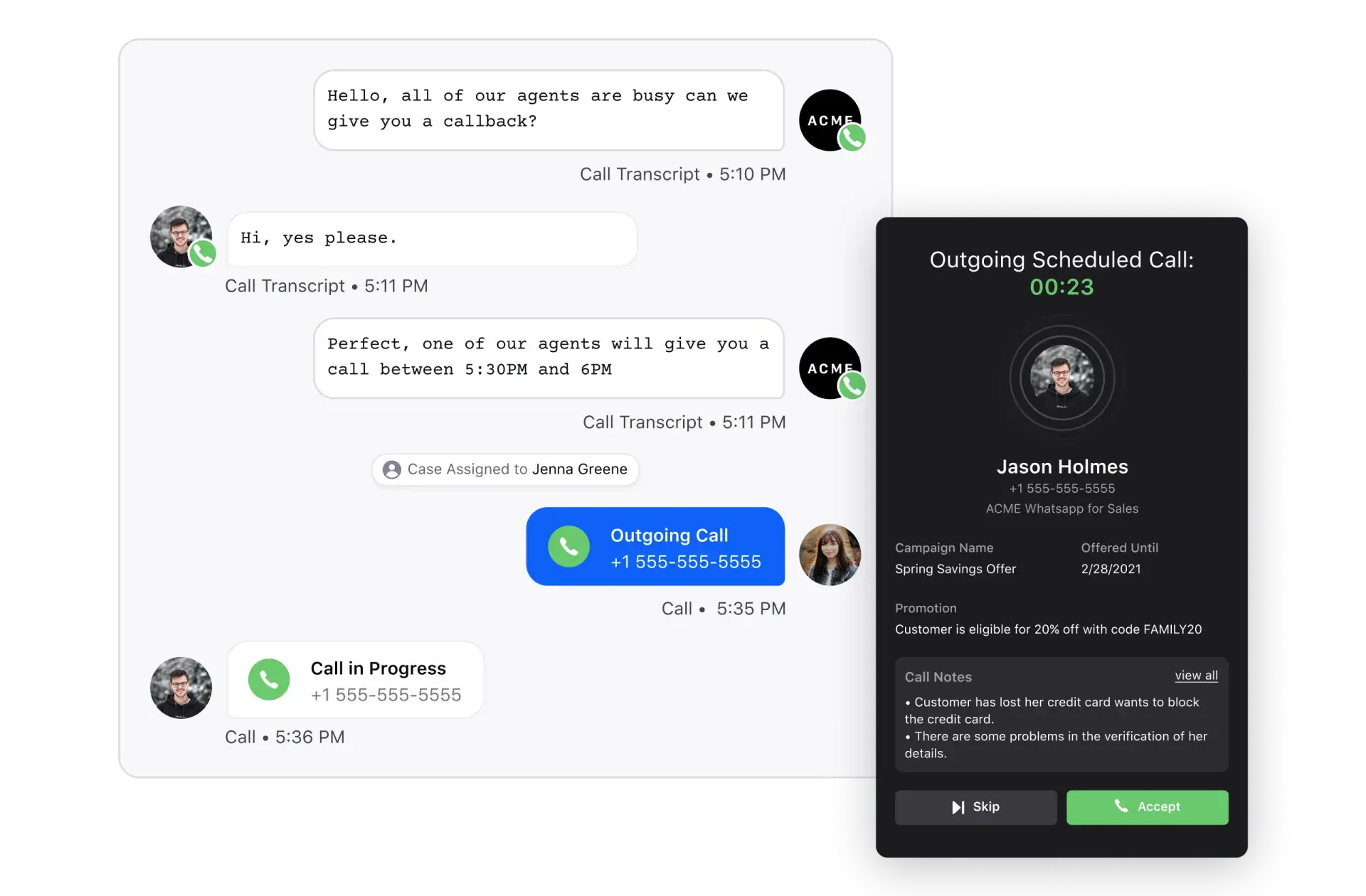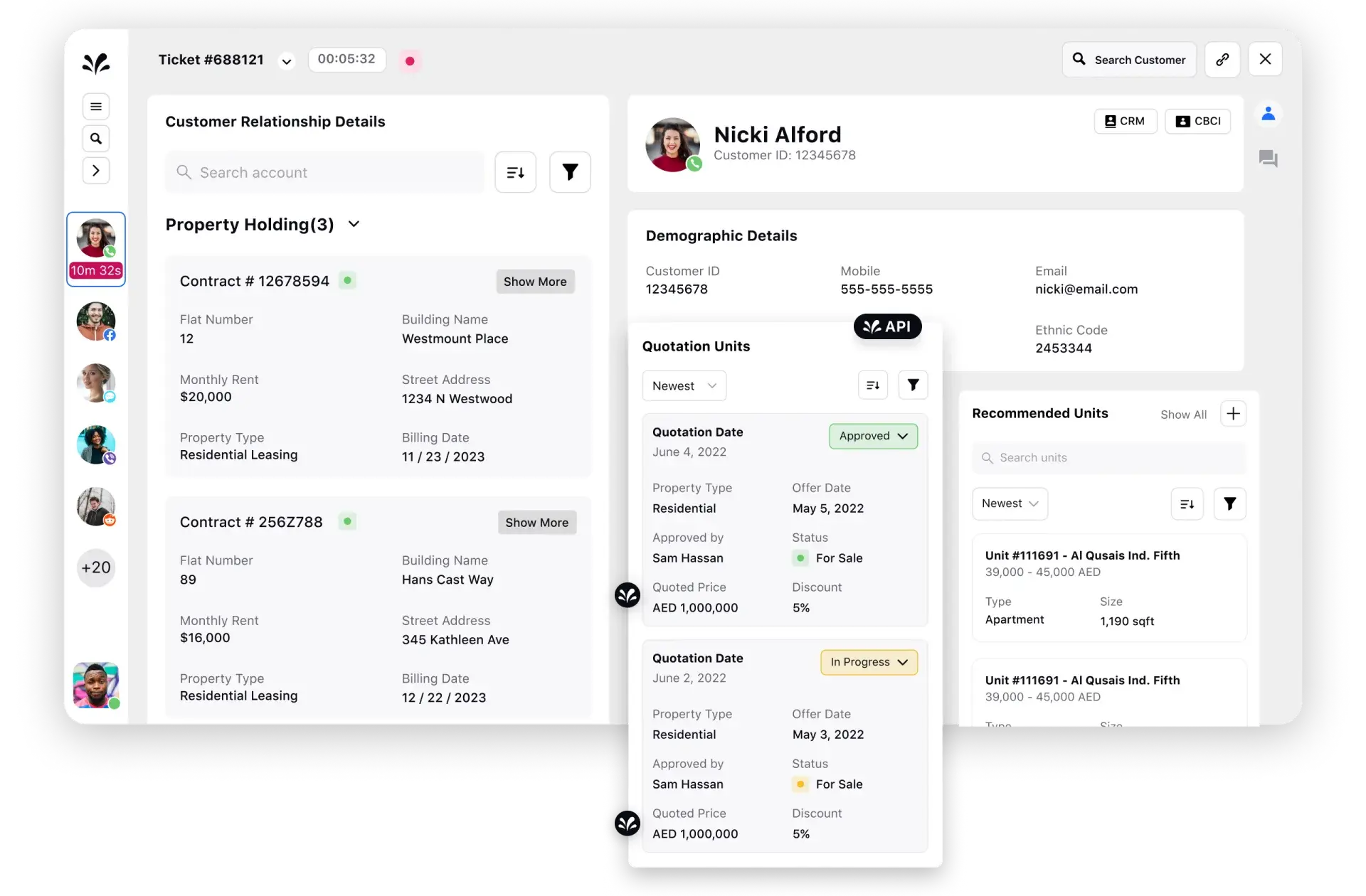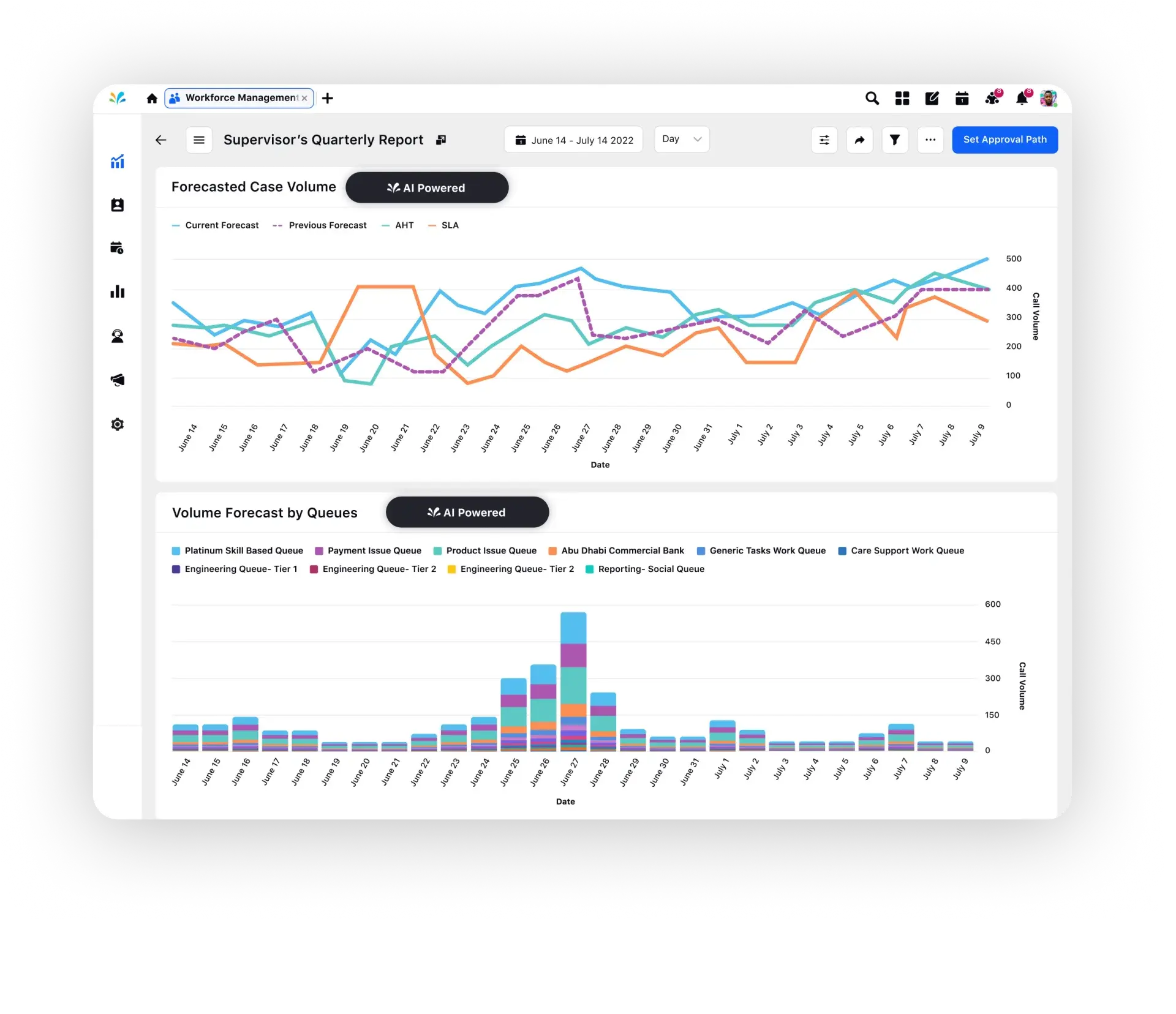What is an inbound call center?
An inbound call center is a customer service operation where agents primarily handle incoming customer calls. These calls range from customer inquiries and technical support requests to order processing and complaint resolution. Unlike outbound call centers, which focus on proactive outreach, inbound call centers are designed to be reactive, providing assistance and solutions based on the customer’s immediate needs, which typically include the following:
Customer support: Companies rely on inbound call centers to resolve customer issues, answer queries and offer technical assistance. Industries like technology, telecommunications and e-commerce heavily rely on inbound call centers to offer timely and effective support regarding placing orders, tracking shipments, managing returns or exchanges and troubleshooting, as they significantly impact customer satisfaction and loyalty.
Billing and payments: Financial services and utility companies use inbound call centers to handle billing inquiries, process payments and address discrepancies.
Product or service information: Inbound call centers serve as a resource for customers seeking detailed information about a company’s products or services. Whether it’s explaining features, providing pricing details or offering recommendations, inbound call centers help customers make informed decisions.
Appointment scheduling: Healthcare providers, legal firms and other service-oriented businesses use inbound call centers to manage appointment scheduling.
Complaints and feedback management: By addressing customer grievances promptly and professionally through inbound call centers, companies can prevent negative experiences from escalating and use the feedback to improve their products, services or processes.
Typical roles within an inbound call center
Every inbound call center relies on a team of dedicated professionals to deliver exceptional customer service. Let’s examine the key roles that make it all happen:
🎧 Agents: Agents are the frontline representatives who handle incoming calls, serving as the direct link between the company and its customers.
👨💼 Supervisors: Supervisors monitor call center metrics, provide real-time feedback and conduct regular training sessions to help agents refine their skills.
💻 IT support: The IT support team ensures that all systems, software and communication tools function seamlessly.
🔍 Quality assurance (QA) analysts: QA Analysts work closely with supervisors and agents to ensure that the call center’s quality benchmarks are met and customer interactions are effective and aligned with the company’s values.
🤵 Customer experience (CX) managers: Customer experience managers oversee the overall customer journey within the call center. They focus on enhancing the customer experience by identifying pain points and implementing strategies to address them.
Inbound call center vs outbound call center
Both inbound and outbound call centers play vital roles in business operations. Understanding these differences can help you choose the right kind of call center for your needs:
Aspects | Inbound call center | Outbound call center |
Primary function | Handle incoming calls from customers | Make outgoing calls to customers or prospects |
Purpose | Provides customer support, resolves issues and answers inquiries | Generates leads, makes sales and conducts market research |
Call initiation | Customers initiate the calls | Agents initiate the calls |
Performance metrics | Average hold time, first call resolution rate, customer satisfaction | Conversion rate, number of leads generated |
Typical reaction | Reactive - Responding to customer needs, troubleshooting, order assistance, account management | Proactive - Sales pitches, customer surveys, appointment setting |
Deep Dive: Inbound vs. outbound call center: Which is right for your business?
How inbound call centers work
Inbound call centers operate through a structured and coordinated process to efficiently manage incoming customer calls. Here's a breakdown of how they typically function:
1. Call routing and queuing
When a customer contacts an inbound call center, the call first interacts with the interactive voice response (IVR) system. The IVR system manages the initial phase of the customer interaction, guiding the caller through a series of options or gathering essential information, such as the reason for the call or the caller's account details. This information is crucial for ensuring the caller is directed to the right resource.
Once the caller has provided the necessary input, the IVR system hands off the call to the automatic call distributor (ACD). The ACD is responsible for routing the call to the most appropriate agent or department based on predefined criteria, such as the nature of the inquiry, agent availability and the specific skill set required to address the issue.
If all agents are occupied, the call is placed in a queue, waiting until an agent becomes available. During this time, callers typically listen to on-hold music or pre-recorded messages from the brand, which can be an opportunity to share helpful information or promote services.
💡Pro Tip
No one enjoys waiting in a call queue. Modern call center software leverages AI to give callers a real-time estimate of their wait time, setting clear expectations and reducing frustration.
However, Sprinklr’s conversational IVR software takes this a step further. If the estimated wait time is too long, Sprinklr AI offers customers the option to switch to alternative channels such as live chat or WhatsApp or schedule a callback. This proactive approach demonstrates your customer-centricity, portraying your brand as one that truly prioritizes customers over anything else.

2. Call handling
Once a call is connected to an agent, the agent's primary task is to greet the customer warmly, listen attentively to their inquiry and work diligently to resolve the issue or provide the requested information. Call center agents are extensively trained to handle a broad spectrum of customer needs, ranging from simple inquiries to complex technical issues, showcasing their versatility and preparedness for any situation.
To enhance the service experience, agents often access customer data through a contact center CRM system. This system provides a comprehensive view of the customer's history and preferences, enabling the agent to deliver personalized customer service and tailored solutions that resonate with the customer's past interactions.
How Sprinklr Helps
Inbound call centers can be high-pressure environments, a reality that customers may not always recognize. While agents are trained to resolve queries efficiently, complex issues can sometimes extend the average handling time, leading to potential customer dissatisfaction. This is where AI can elevate the customer service experience.
Sprinklr’s agent assist software, powered by Sprinklr AI+, significantly eases the burden on agents. By automatically recommending similar resolved cases, relevant knowledge bases and guided workflows based on ongoing conversation, Sprinklr AI enables agents to resolve issues up to 50% faster. Learn more about agent assist.

3. Call monitoring and quality assurance
Supervisors and QA teams listen to live calls or call center recordings to assess the agent's performance, focusing on aspects such as communication skills, problem-solving effectiveness, adherence to scripts or protocols and overall customer satisfaction. Feedback from these evaluations is then used to coach agents, helping them improve their performance and better handle future interactions.
In addition to real-time call center quality monitoring, supervisors and the QA team use call center analytics to identify patterns, trends and areas for improvement.

4. After-call work (ACW)
After the call concludes, the agent engages in after-call work (ACW). This phase involves several critical tasks: updating the CRM with detailed notes about the interaction, tagging the call for specific follow-ups if needed and completing any additional tasks related to the call. Efficient ACW is crucial for maintaining productivity and ensuring all customer interactions are well-documented for future reference.
ACW may also encompass follow-up actions such as sending confirmation emails, scheduling callbacks or conducting customer satisfaction surveys. These follow-up measures ensure the customer’s experience is complete and satisfactory, providing a seamless transition from the initial interaction to resolution.
5. Data collection and analysis
Inbound call centers collect vast amounts of data during customer interactions. This data includes call center metrics (such as call duration, hold times and first-call resolution rates), customer feedback and recurring issues or trends. The data is then analyzed to gain insights into customer behavior, identify areas for improvement and build customer-centric strategies.
6. Continuous improvement
To remain competitive, inbound call centers must continually refine their processes, adopt innovative technologies and invest in ongoing call center agent training. This commitment to improvement ensures that agents can build strong customer connections regardless of the nature or length of the call.
Top benefits of effective inbound call centers
Inbound call centers serve as a critical customer touchpoint and play a pivotal role in customer satisfaction. By transforming and optimizing, businesses can unlock numerous benefits. Let’s explore the top advantages:
🗣️ Customer feedback and insights
Effective inbound call centers do more than address issues — they are valuable sources of consumer insights and feedback. Through direct interactions, agents collect crucial information about customer preferences, pain points and expectations. This feedback is systematically gathered and analyzed to identify trends and opportunities for improvement.
Understanding customer needs enables businesses to refine their products, services and overall customer experience. In fact, 70% of leaders are investing in technology to harness the voice of the customer and enhance service experiences in 2024.
😊 Enhanced customer satisfaction and loyalty
Did you know that 58% of consumers are willing to pay more for a positive customer service experience? Efficient inbound call centers ensure that customer inquiries and issues are resolved promptly and accurately, leading to increased satisfaction.
When customers feel valued and their issues are addressed effectively, they are more likely to remain loyal to your brand. This loyalty translates into higher customer retention, which is essential for long-term success.
📈 Increased operational efficiency and reduced costs
Inbound call centers use advanced call center technologies such as IVR and ACD systems to enhance operational efficiency. These tools reduce call handling times and ensure calls are routed to the appropriate agents, allowing businesses to manage more calls with fewer resources.
Top-performing call centers often achieve a first-call resolution (FCR) rate of 74% or higher. Efficient call handling minimizes the need for repeated follow-ups, ultimately saving both time and resources.
🌟 Elevated brand reputation
Delivering consistent customer service is vital for building a solid brand reputation. Customers who have positive experiences are more likely to share them through word-of-mouth or online reviews, which can attract new customers and reinforce trust with existing ones.
Good Read: Brand Reputation Management: A Guide to Get Organized
How to overcome challenges faced in inbound call centers
Inbound call centers often face significant challenges impacting their ability to deliver top-notch service. Let's explore some common hurdles and strategies for overcoming them.
Challenge #1: Handling high call volumes
Inbound call centers often grapple with a surge in call volume and the increasing complexity of customer inquiries. This can lead to a variety of challenges, including:
Long wait times: As call volumes rise, customers may face lengthy wait times before connecting with an agent. This can lead to frustration and a negative customer experience.
Difficulty providing personalized service: When agents are overwhelmed with calls, it becomes challenging to provide personalized and attentive service to each customer, which can negatively impact customer satisfaction.
Inefficient resource allocation: It can be challenging to allocate resources effectively when call volumes fluctuate and inquiries vary in complexity. This can lead to underutilized agents or overwhelmed teams.
🔧 How to Tackle
AI-powered chatbots and conversational IVR systems can handle simple inquiries and enable customers to find solutions to common issues on their own. When a more complex problem arises, these tools can smoothly direct the call to the appropriate agent, reducing wait times and ensuring smooth operations.
Secondly, a unified agent desktop can make things easier for your agents. A single-screen view allows agents to handle multiple interactions simultaneously, with easy access to conversation history and customer details across different communication channels. Combined with the knowledge base, CRM system and AI-powered agent assist feature, this setup allows agents to resolve queries twice as quickly.

Challenge #2: Dealing with irate or demanding callers
Handling irate or demanding callers can be particularly stressful for agents and may impact their performance and job satisfaction. While we have a detailed blog on how to deal with angry customers, to address such challenges effectively, consider the following strategies:
🔧 How to Tackle
📑 De-escalation training: Invest in comprehensive de-escalation training programs for your agents. These programs equip agents with techniques to manage difficult conversations calmly and professionally. By mastering de-escalation strategies, agents can diffuse tense situations more effectively, reducing stress and improving the overall outcome of the call.
🤝🏻 Supportive work environment: Foster a supportive work environment by providing access to mental health resources and ensuring agents have regular breaks. A positive and supportive atmosphere helps agents cope with the stress of handling challenging calls, which maintains their effectiveness and positivity during interactions.
📑 Escalation protocols: Implement clear escalation protocols that allow agents to transfer calls to supervisors or more experienced staff when necessary. This ensures that those with more expertise handle complex or high-stress issues, improving the customer experience and alleviating some pressure on front-line agents.
📌 Must Read: Escalation Management: How to Manage It Effectively
Challenge #3: Managing diverse customer expectations and languages
If you operate globally, you’ll encounter customers with a wide range of expectations speaking different languages. This diversity can make it challenging to deliver consistent and satisfactory service.
🔧 How to Tackle
🙏🏻 Cultural sensitivity training: Provide agents with cultural sensitivity training. For instance, training could include educating agents on the significance of certain holidays or traditions. This will allow them to acknowledge and respect these occasions when interacting with customers from diverse cultural backgrounds. This will enhance their interactions and help build stronger, more meaningful customer relationships.
🌎 Multilingual support: To bridge language barriers, consider setting up virtual call centers and hiring remote agents in the regions where you operate. Virtual call centers allow you to function 24x7 globally and automatically route calls to available agents, ensuring that customers always reach someone who can assist them in their preferred language.
🤖 Multilingual chatbot: Implementing multilingual chatbots is another option you have. These chatbots can interact with customers in their chosen language, providing immediate responses and assistance. This approach helps overcome language barriers and makes your service accessible to a broader audience 24/7.

Challenge #4: Call center burnout
Dealing with a constant influx of calls, particularly complex inquiries, can be mentally taxing for agents. This can contribute to call center burnout, disengaged agents and high turnover rates. According to Gartner, only one in three customer service reps are engaged and disengaged reps are 84% more likely to look for a new job. On top of that, replacing customer service reps, on average, costs a whopping $14,113 per rep.
🔧 How to Tackle
📊 Employ an AI-powered workforce management tool
Modern workforce management platforms do the heavy lifting here. Using AI for call center forecasting, you can accurately predict future case volumes, handling times and SLAs for all channels based on historical data. These tools also allow flexibility in adjusting schedules and running 'what if' scenarios. You can simulate staff shrinkage, AHT, occupancy and SLAs at a detailed level to effectively determine workforce capacity requirements and schedules.
Read more: Workforce Management: Step-by-Step Process & Benefits

Tired of struggling with overwhelming call volumes and frustrated customers?
Sprinklr Service is your solution. Sprinklr’s advanced call management features, powered by Sprinklr AI, streamline operations, boost agent efficiency and deliver exceptional customer experiences.
Ready to see how it all works together? Schedule a session with our experts today!
Frequently Asked Questions
Thank you for contacting us.
A Sprinklr representative will be in touch with you shortly.
Contact us today, and we'll create a customized proposal that addresses your unique business needs.
Request a Demo
Welcome Back,
No need to fill out any forms — you're all set.



